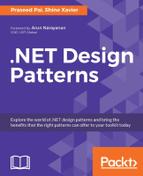In this chapter, we will try to create a library which will help application developers target their applications against SQL Server, SQLite, MySQL, and Oracle. As a result of creating this library, we will be able to write the application code without worrying about the underlying persistence technology. Even though ADO.NET does a wonderful job of abstracting away the nitty-gritties of a relational database management system (RDBMS), we need more than what is available as a stock feature within ADO.NET to write a database-agnostic persistence layer.
During the course of this chapter, as a reader, you will learn to leverage the abstract factory pattern, factory pattern, and the adapter pattern to be able to do the following:
- Interfacing with various ADO.NET providers
- Writing persistence-store agnostic logic
- Writing data to an SQLite database
- Writing data to an SQL Server database
- Writing data to an ODBC data source
Before we embark on writing the library, let us scribble down a preliminary requirement statement as follows:
